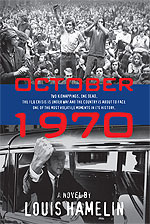This was a palate cleanser year for me with respect to Canada Reads, an annual Canadian literary event I’ve followed regularly since its inception in 2002. (Here’s a handy summary of the books, book defenders, moderators and more, including the parallel lineups for the French language equivalent, Le Combat des livres.) I’ve been most engaged in the books, the discussions and the featured debates since 2011, the year the event was extended to invite more online participation.
Perhaps I’ve been so engaged since then that I’ll admit, I experienced a touch of Canada Reads fatigue going into the ramp-up to this year’s debates. I’d mused a year earlier …
“… you know, part of me wishes I could go into the debate one of these times to be convinced without having read any of them, or to test with some purity whether the debates stand on their own as a truly useful way of being introduced to the books. Of course, the debates can’t help but be predicated on some beforehand knowledge of the books and authors. Anyhow, it’s not how Canada Reads books have come to be marketed nowadays, is it? The five-book packages and bookstore displays started in November, and we’re meant to respond. Still, don’t you think it’d be an interesting approach to learning about the books to intentionally go in blind one year?” (from Some thoughts on Canada Reads Eve [February 9, 2013])
So, that’s what I did this year.
-
I did previously read one of the books – Annabel by Kathleen Winter. I didn’t reread it, nor did I read any of the other contenders until after the Canada Reads 2014 debates finished and a winner was chosen.
-
As in previous years, I continued to gather and read reviews and articles about all of the finalists. I assembled links to those pieces in my ongoing Canada Reads 2014 virtual book club blog post.
-
I recruited five wise, well read and expressive friends and colleagues to review the five finalist books, with a view to the strength of each book and how they thought the books fit the Canada Reads 2014 theme of “What is the one book that could change Canada?” Here is what my guest reviewers had to say:
- The Orenda, by Joseph Boyden – reviewed by Cheryl Finch
- Annabel, by Kathleen Winter – reviewed by Natasha Hesch
- Half-Blood Blues, by Esi Edugyan – reviewed by Sue Reynolds
- The Year of the Flood, by Margaret Atwood – reviewed by Rebecca Hansford
- Cockroach, by Rawi Hage – reviewed by Paul Whelan
Taking this approach, I went into the debates feeling refreshed, with some new perspectives and very curious to see how the celebrity defenders were going to do their jobs. I’ll also admit that I emerged from the 2014 Canada Reads debates feeling entertained, challenged and energized, having had my thoughts about the contending books and subject matter provoked in all sorts of positive ways.
Bearing in mind that Canada Reads is not just a battle of books, but the alchemy of theme, book, defender, strategy and a dollop or two of the unexpected, the 2014 edition delivered … and some. The two final defenders – Wab Kinew, championing Joseph Boyden’s The Orenda and Samantha Bee, championing Rawi Hage’s Cockroach – were two of the most determined, articulate, well prepared and quick thinking combatants the program has ever seen (Bee’s periodic dips into weepiness notwithstanding). Add to that the eminence, eloquence, gravitas and revelatory humour of statesman Stephen Lewis, and the program boasted some of the most balanced, respectful and riveting Canada Reads exchanges ever, such as the Kinew-Lewis debate about violence and torture in The Orenda.
You could almost put aside the books here and argue that the arguments themselves were the most potent and inspiring aspects of this year’s program.

Interestingly, the tenacity with which the book/defender combination of Bee/Cockroach made it to the final round had me the most intrigued throughout. That’s the Canada Reads finalist book I’m going to read first, based on both Samantha Bee’s spirited and resourceful defence, as well my friend Paul Whelan’s great review.
Suggestions for next year? On the basis of the invigorating discussions this year, I know I’ll be interested again in 2015, and would love to submit the following ideas for consideration:
-
Thematic idea #1 How about an examination of indelible characters in Canadian literature that all Canadians should get to know … but not the usual suspects, like Anne of Green Gables or Duddy Kravitz? I’d nominate the likes of Maggie Lloyd from Ethel Wilson’s Swamp Angel, Desmond Howl from Paul Quarrington’s Whale Music, Sheilagh Fielding from Wayne Johnston’s The Custodian of Paradise or Egg from Tamai Kobayashi’s Prairie Ostrich.
-
Thematic idea #2 How about books that will introduce you to the complete works of (perhaps) underappreciated or unknown authors, or authors that have slipped a bit below the CanLit radar? How about selections from the works of Barbara Gowdy, Matt Cohen, Robertson Davies or Judith Merril, for example?
-
Host/moderator The inaugural Canada Reads in 2002 was moderated by actor/comedian Mary Walsh. For the next five years, Canada Reads was moderated by author and broadcaster Bill Richardson. For the last seven years, Jian Ghomeshi has helmed the program. Is it maybe time to give Jian a well-deserved break and seek a change in the moderator’s chair? (Heck, if he is reluctant to completely disengage, Jian could probably be an able book defender.) While there are already calls for him for Prime Minister, a good interim role for Wab Kinew might be as an incisive and astute moderator who would bring an informed sensibility to the proceedings. His impressive acumen in this year’s Canada Reads proceedings was enhanced by his overall preparedness and knowledge of all of the books, and his ability to respect his opponents without being either hostile or overly ingratiating. I think he could manage a future Canada Reads competition with equanimity and aplomb. Just a thought …

See also:







